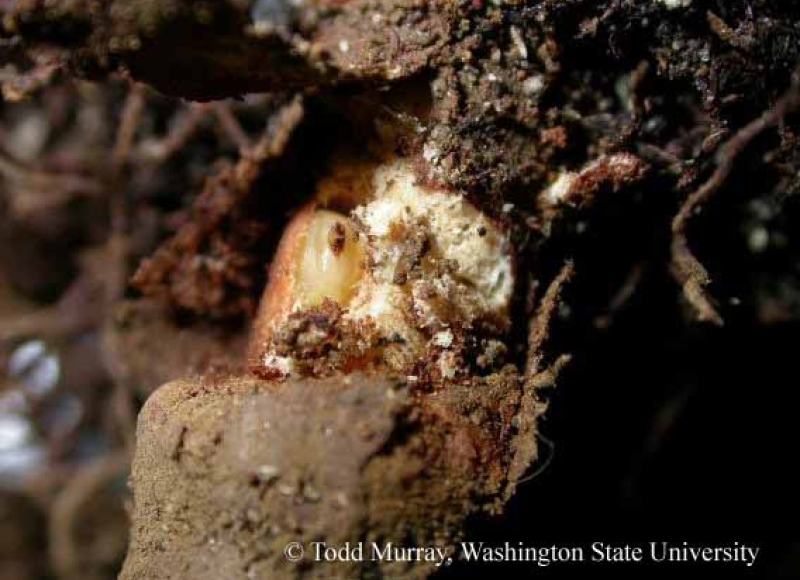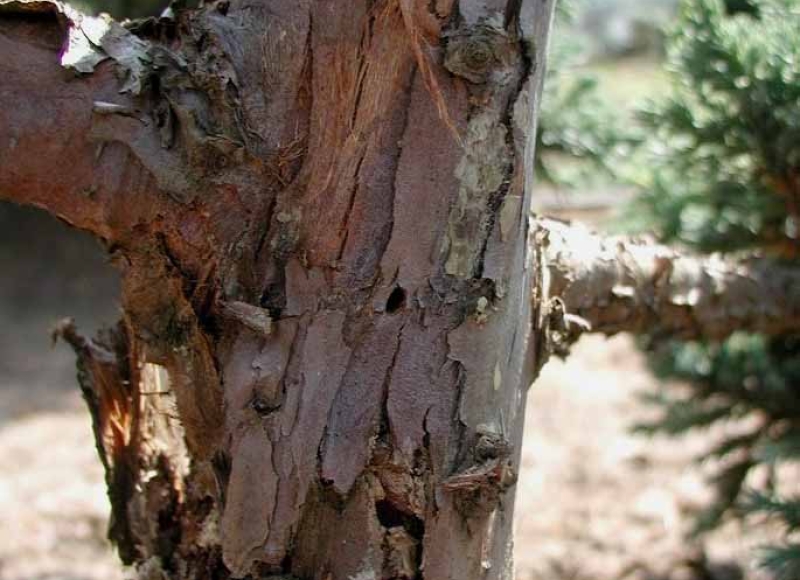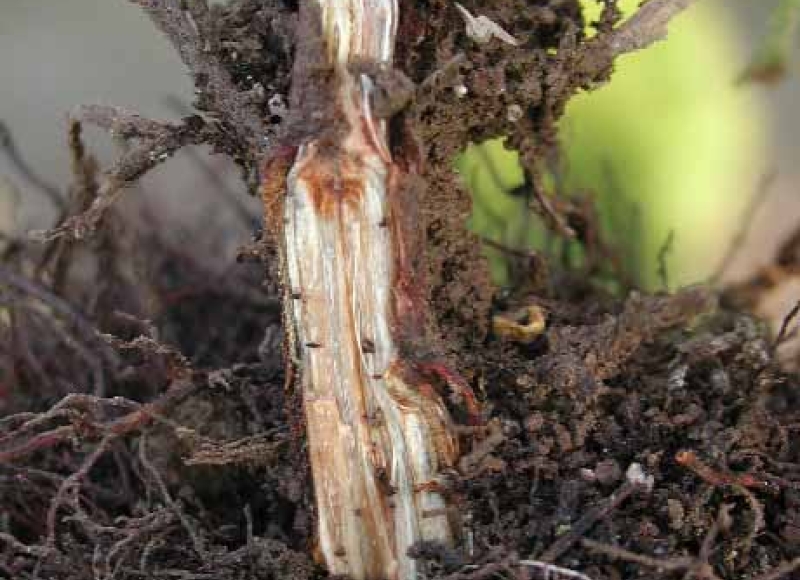Your gaze roams over the young field of arborvitae, then lingers. There in the corner, disappointing the symmetry of green rows, stand yellow and brown stalks of dying Thuja. Mourning the immediate loss, you wonder what fiend has robbed you of potential profit. You may share the nursery with a squatter. The uninvited resident is the flatheaded cedar borer (FCB), Chrysobothris nixa, a native beetle who won't hesitate to call your plants home.
There is scant literature on flatheaded cedar borer and little documentation of its life cycle, impact, and management in nursery systems. These borers tunnel into plants in the Cupressaceae family. According to Richard Westcott at the Oregon Department of Agriculture and an authority on this family of beetles, C. nixa has been reported from California, Montana, Nevada, Oregon, and Washington, and from British Columbia from the following hosts: Calocedrus decurrens, Cupressus macrocarpa, Cupressus forbesii, Cupressus nevadensis, Juniperus occidentalis, and Thuja plicata. Schuh & Mote in their 1948 publication, Insect Pests of Nursery and Ornamental Trees and Shrubs in Oregon, do mention C. nixa as a species ". . . very common in nurseries in various varieties of junipers and arborvitae" and that ". . . attacks always seem to be in plants that have been injured by hoe, by cultivator, or by breakage of the limbs from the main trunk." No life cycle information was mentioned in these references. Westcott thinks these borers might have a two-year life cycle in this region.
The flatheaded cedar borer is a buprestid beetle. This family of beetles is so named due to the flattened pronotum just next to the head of the juvenile or larval stage of the beetle. This character is extremely useful for identification of this family of borers. The larval grub is legless and elongate, pale white with a dark brown head capsule. The adult beetles are 0.35-0.57 inches long, slightly metallic, brown to black flattened beetles. The overall look of these buprestid adults is described as bullet-shaped. This shape, looking straight on head-to-tail, also accounts for the D-shaped emergence hole associated with their exit from the tree. Their wing covers are sculptured and finely serrate along the outer edge at the rear. In fact Chrysobothris means gold trenches referring to its shiny sculpturing.
A common field pattern seen with this borer's damage is an edge effect. This is particularly noticeable near the exterior of a nursery adjacent to forest borders. The infestations often appear in the field as hot spots involving several plants adjacent to each other. The plants are generally weak and spindly. The foliage in affected fields of arborvitae can range from light green to yellow, tan, nearly orange, and brown - undesirable traits in plants not grown for fall color.
Individual plant damage can be one-sided depending on the site of feeding. Most damage occurs near the base of the plant, commonly at the soil line. Flatheaded borers tunnel extensively in the shallow, cambial tissue. They can inflict much damage to a woody plant. This feeding so near the bark's surface makes damage more evident, revealed in mushy wood and clumped sawdust-like brown frass in the galleries. Carefully scraping off the outer layers of the wound with a knife may discover the grub concealed within. Larger larvae can also be found deeper within the stem as they prepare to overwinter in the fall. In the spring, weeping of sap near damage and emergence holes of the adults can be seen on junipers.
The dreams of a flatheaded cedar borer surely include the convenience of a dense patch of host material, arborvitae, juniper, or cedar, grown in a concentrated resource system, a nursery. Add the right conditions: conifers basking in the hot dry sun where the sprinklers fail to travel adequately. Their thirst evident, the parched plants attract the attention of a female borer taking flight in late spring through the summer. As she flies she assesses the real estate. Seeking a dwelling for her offspring she veers toward an off-colored plant. Her inclination is to find a plant host too stressed to successfully ward off her penetrating progeny. This eases the path for establishment and survival of her young. Satisfied with her pick, she may lay an egg in the bark crevices near the base of the plant.
Management generally aims at reduction of plant stress, removal of infested materials, and protection of high value susceptible plants. How does one successfully attract a burgeoning flatheaded cedar borer population? Drought stress works well. Irrigation management to consistently meet water demands is critical. Summer-planted arborvitae appears more susceptible than spring-planted. The spring-planting allows more time to establish root systems which can withstand summer heat and moisture extremes.
Adjust cultural activities when justified. Ordinarily a grower may base the timing of juniper pruning on non-peak demand for his available labor. Suffering a borer, it can be useful to think entomologically, avoiding pruning during the flight time of the beetle. Pruning cuts are thought to attract borers by emitting a volatile chemical perfume and visual cues irresistible to these opportunists. The female FCB may fly from mid-May through August (the majority of specimens collected in Oregon have occurred from early June through mid-July). Westcott reports that the earliest specimens he has in collection emerged on May 15 and May 29. If pruning is required during this potentially long flight period, timing should avoid periods of plant stress. Once infested plants are identified, shrubs can be rogued and burned, chipped or removed from the production site. Be sure shrubs burn thoroughly if burn piles are used.
Currently infestations tend to be sporadic, limited, and unpredictable. Chemical control under those conditions is likely not economical. High value plants may warrant protective
applications during the flight period. A search for products that are labeled specifically for flatheaded cedar borer was unsuccessful. Some products though, such as Dursban and Discus, have flatheaded borers on their labels for nursery sites and may have efficacy against this borer as well.
Learn what attracts these beetles to a site and you might learn what will deter them. When next these borers come to visit, give them a little dose inhospitality and keep Oregon arborvitae green.
Literature:
Furniss, R. L., and V. M. Carolin. 1977. Western forest insects. U.S. Department of Agriculture, Miscellaneous Publication 1339. Washington, DC. 654 p
Schuh, J. and D.C. Mote. 1948. Insect Pests of Nursery and Ornamental Trees and Shrubs in Oregon. Agricultural Experiment Station, Oregon State College, Corvallis. State Bulletin 449. 163 pp.
Acknowledgements:
My thanks to Todd Murray, WSU; and Richard Westcott and Richard Worth, Oregon Department of Agriculture for their assistance developing and reviewing this site.
Original version: <25 October 2004)
Last revision <20 June 2018>
Author: R.L. Rosetta, Extension Nursery Integrated Pest Management, Department of Horticulture, Oregon State University/NWREC.











